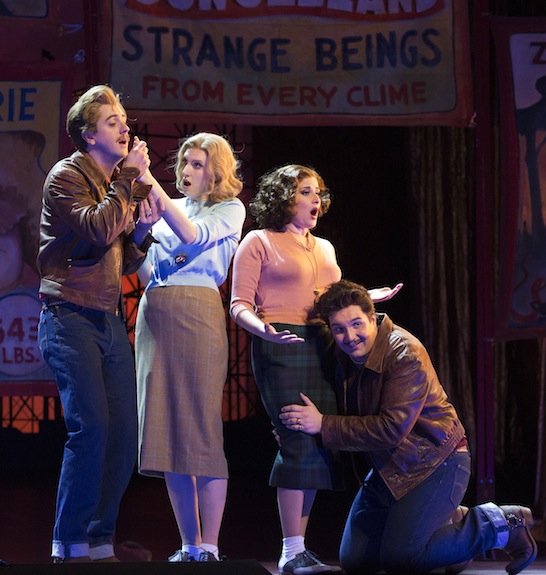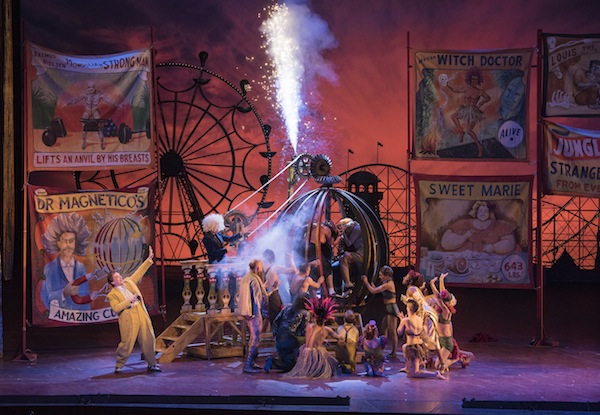New Met Mozart scores with a colorful carny “Cosí”

Ben Bliss, Amanda Majeski, Serena Malfi, and Adam Plachetka in Mozart’s “Così fan tutte” at the Metropolitan Opera. Photo: Marty Sohl
In his excellent book, Opera as Drama, Joseph Kerman described Cosí fan tutte as problematic due to what he termed the perfection of its libretto. That libretto, by Lorenzo Da Ponte, is so finely made that it becomes something of an abstraction, a set of actions that on their own terms make sense but in a human drama are hard to resolve.
Thursday night the Metropolitan Opera premiered their new production of Cosí —made in partnership with the English National Opera—that is set by Phelim McDermott in 1950s Coney Island. While some memories may bring up Peter Sellars’ 1980s production set in a diner, the two are very different in terms of what the directors see in the drama and how they present it.
Cosí is superficially a sex farce and underneath just plain odd. Fernando (tenor Ben Bliss) and Guglielmo (bass-baritone Adam Plachetka) are engaged to sisters Dorabella (mezzo Serena Malfi) and Fiordiligi (soprano Amanda Majeski). They meet Don Alfonso (baritone Christopher Maltman) who is gleefully cynical in all things and doesn’t believe in the constancy of women. He wagers that if the two men disguise themselves they will the be able to seduce each others’ girl. Game on, hi-jinks ensue, but in disguise the two men not only seduce the girls but marry them. The truth is then revealed and everyone goes home…happy?
Does this joke get out of hand and take on a life of its own, to the despair of all, or do the principals just pull themselves back from the edge, having touched a dangerous sensation but no worse for the wear? This is one of the trickiest balances in all of opera.
Mozart’s music is so sympathetic to the characters, which in a way puts it at odds with the libretto, which needs some cynicism to exist. Mozart loved his characters in all his operas (except perhaps Don Giovanni) and that humanity underlies all the vivaciousness, grace, and technical brilliance of this score. Da Ponte’s perfect simulacrums of people collide with Mozart’s soulfulness, and that also makes Cosí easy to play but hard to make work.
McDermott does make this work, not only as entertainment—and it is richly entertaining—but as a touching, generous experience. There is the sheer beauty and cleverness of the staging—the backdrop of the Wonder Wheel and the Cyclone, with the sun at various points in the sky, is gorgeous. A Skyline Motel set fits the ’50s look and also makes for some slapstick.
Along with the singers there is what the program describes as a “Skills Ensemble,” made up of carnies straight from present- day Coney Island, and likely recognizable to many nonaficiondos; Betty Bloomerz, Leo the Human Gumby, Titano Oddfellow, Sage Sovereign, and more. To say they add to the entertainment is an understatement—they are integral to the success of Phelim’s staging.
Working with Don Alfonso and shading that character as a ringleader/carnival barker, they all tumble out of a trunk during the overture, holding placards that come together to describe what the audience will experience, words like “lust,” “sophistication,” and “chocolate.” On stage, swallowing swords, playing with fire, handling snakes. They do at times distract from the singers, but that deepens the feeling that this is not just dressing up Cosí in modern trappings, it is using modern experience to clarify and deepen the opera’s meaning.

Photo: Jonathan Tichler
Ferrando and Guglielmo are naval officers (the excuse for their disappearance is that they are called off to war) and in the first couple of scenes they were bland, their singing rather colorless. But when Bliss and Plachetka reappeared in disguise, with pompadours and fake mustaches, sport shirts, cuffed jeans, and leather jackets—Albanians, perhaps, certainly a recognizable ethnic type from the streets of Brooklyn—their singing was vital and engaged. Bliss’s graceful, flowing performance of “Un’aura amarosa” was the most musically compelling moment of the performance. Plachetka, meanwhile, uniform gone. brought out his natural extroversion.
Majeski’s “Come scoglio” was not as satisfying, with the most emphatic and meaningful phrases laying below her most effective range. “Per pietà, ben mio, perdona,” was much more fitting for her voice, which was at its best in the higher range. Malfi was good at unbuttoning Dorabella, and particularly strong throughout Act II, the dark color of her voice filled increasingly with warmth, singing a lively “È amore un ladroncello.”
Meanwhile, Maltman was his typical self as Don Alfonso, the edge in his voice both engaging and threatening, full of confidence and energy. He’s also helped by some outrageous costumes, including a yellow zoot suit and at the end a red sequined number that is out of Max Headroom.
Soprano Kelli O’Hara pretty much stole the show as the maid, Despina, even when she wasn’t singing. A Broadway veteran, she had the larger-than-life gestures that project out into the audience. Though her sustained notes weren’t at the level of the other more operatic voices, her soprano was perfect for Despina, who is supposed to be coarser and earthier than the other characters. The production makes clear her casual relationship with Don Alfonso, which was satisfying to see.
The banners that advertise the sideshow performers came to life when Despina appears in disguise as a doctor to save Ferrando and Guglielmo from fake poison. She’s not just any doctor, but the sideshow Dr. Magnetico, and her hilarious treatment is a sparking, mad-scientist contraption. When she appears as the Notary at the end, she’s in a green cowboy outfit (the superb costumes are by Laura Hopkins), line dancing between two sideshow dwarfs.
More than just super-supernumeraries, the carnies are part of the community of which Don Alfonso is so cynical. In fact, it is they who make the finale, the point that makes or breaks this opera, work. In the final bars, the entire cast was on stage in a kind of formal dance, principal characters switching off with carnies. This transferred the intimate foibles, and virtues, of the two couples to everyone.
The staging and performances overshadowed David Robertson and the MET Orchestra. Robertson was in part responsible, delivering a surprisingly subpar performance. There was warmth but not enough energy to match what was on stage, and little crispness in the rhythms and articulations. Tempo and pulse tended to be smeared around the landscape, and the singers and carnies were the ones who drove the music and drama forward.
Cosí fan tutte continues runs through April 19. metopera.org; 212-362-2000.



Posted Mar 18, 2018 at 1:23 am by David H Spence
If I was David Robertson, a very fine musician, I would resign from conducting any further performances of this travesty of a new Met production.
The Nozze di Figaro that opened several years ago is not better at all. The praise for the carnies and all the sideshow in this Cosi Fan Tutte is just so much bullshit. What a way to return Cosi not only to the dark ages of the 1950’s, but also in a way to the really dark ages of the Victorian era, during which this sublime work endured great abuse and neglect.